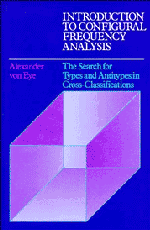 Introduction to Configural Frequency Analysis
Introduction to Configural Frequency Analysis Book contents
- Frontmatter
- Contents
- Preface
- Part I Concepts of configural frequency analysis
- Part II Applications and strategies of CFA
- Part III Methods of longitudinal CFA
- Part IV Strategies of CFA and computational issues
- Appendix A Computational issues. The estimation of tail probabilities for the standard normal and the F distributions
- Appendix B Estimation of expected frequencies in 2 × 2 × 2 tables under the assumption that main effects and first order interactions exist
- Appendix C Critical alpha levels under Holm adjustment for up to 330 cells and a priori alphas 0.05 and 0.01
- References
- Subject index
- Author index
Part III - Methods of longitudinal CFA
Published online by Cambridge University Press: 04 August 2010
- Frontmatter
- Contents
- Preface
- Part I Concepts of configural frequency analysis
- Part II Applications and strategies of CFA
- Part III Methods of longitudinal CFA
- Part IV Strategies of CFA and computational issues
- Appendix A Computational issues. The estimation of tail probabilities for the standard normal and the F distributions
- Appendix B Estimation of expected frequencies in 2 × 2 × 2 tables under the assumption that main effects and first order interactions exist
- Appendix C Critical alpha levels under Holm adjustment for up to 330 cells and a priori alphas 0.05 and 0.01
- References
- Subject index
- Author index
Summary
The following chapters introduce methods of longitudinal CFA. Simple longitudinal designs involve two observation points for one variable. In complex designs several variables are observed for several samples over many points in time. CFA enables one to analyze contingency tables displaying patterns of constancy and change in a unique way. Rather than identifying models of interrelationships among variables across time, CFA identifies cases with patterns that remain stable or show specific changes in behavior. CFA shows which patterns occur more often than expected by chance and what other patterns are very unlikely.
Longitudinal CFA deals with several types of change. For instance, systematic shifts in means may be described as trends, and systematic changes in variability may be described as examples of the “Law of Initial Values” (cf. Wall 1977). The following sections pay special attention to specifying the particular type of change under study, and to the model under which the expected frequencies are estimated.
Most of the models discussed in the above chapters assume independent samples. In longitudinal CFA, samples are no longer independent. Therefore, repeated observations cannot be analyzed with, for instance, k-sample CFA. This approach assumes the k samples to be independent. Treating repeated observations as independent would lead to an artificial increase of the sample size and, therefore, to grossly nonconservative statistical decisions. Thus, the following chapters present methods for the investigation of longitudinal data that avoid these problems.
- Type
- Chapter
- Information
- Introduction to Configural Frequency AnalysisThe Search for Types and Antitypes in Cross-Classification, pp. 143 - 144Publisher: Cambridge University PressPrint publication year: 1990


